E-waste Management in Australia: Policies, Challenges, and Solutions
VerifiedAdded on 2020/05/01
|16
|2521
|131
Report
AI Summary
This report provides a comprehensive analysis of electronic waste (e-waste) management in Australia. It begins with an overview of e-waste statistics, highlighting the increasing volume of discarded electronics and the challenges this poses. The report delves into the role of Australia in e-waste management, evaluating government policies such as the National Waste Policy and the Product Stewardship Act, including both mandatory, co-regulatory, and voluntary frameworks, with a focus on the National Television and Computer Recycling Scheme (NCTRS). The report also examines the ethical dimensions of e-waste management, discussing the responsibilities of individuals, organizations, and the government. Finally, the report offers recommendations for improving Australia's e-waste management, including the implementation of 3-R initiatives (Reduce, Reuse, Recycle), Extended Producer Responsibility (EPR), and promoting citizen responsibility, while also referencing the Basel Action Network (BAN) for a sustainable and hazard-free system.
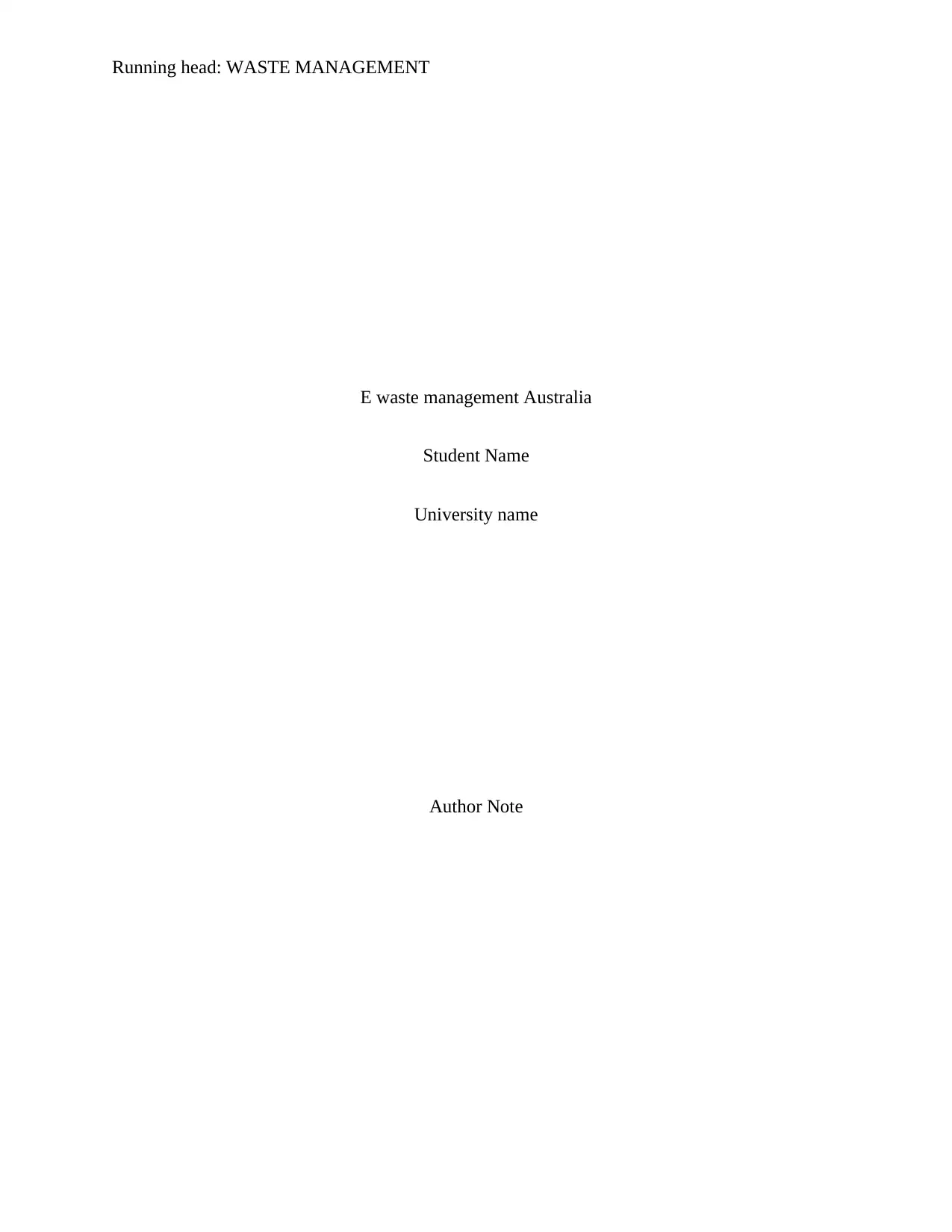
Running head: WASTE MANAGEMENT
E waste management Australia
Student Name
University name
Author Note
E waste management Australia
Student Name
University name
Author Note
Paraphrase This Document
Need a fresh take? Get an instant paraphrase of this document with our AI Paraphraser
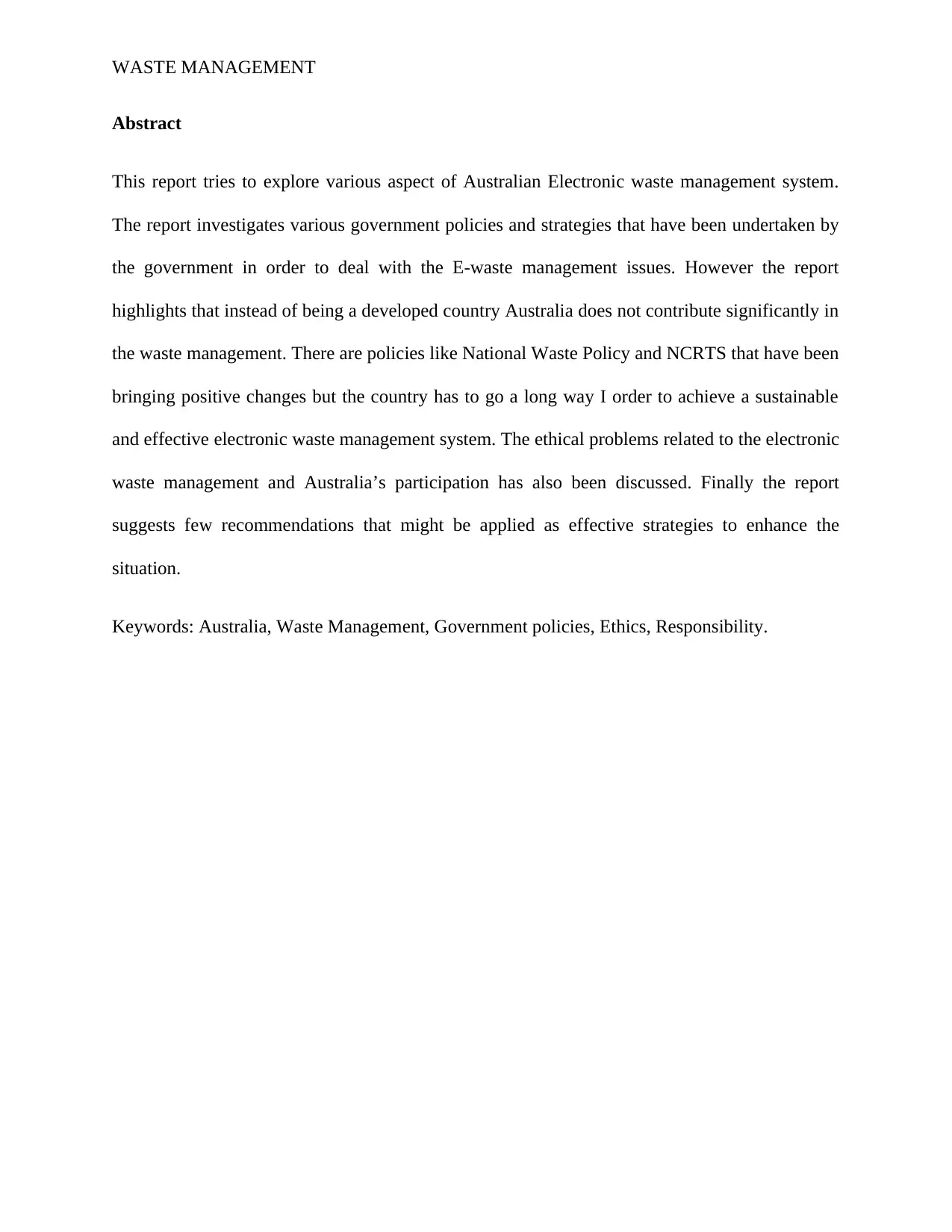
WASTE MANAGEMENT
Abstract
This report tries to explore various aspect of Australian Electronic waste management system.
The report investigates various government policies and strategies that have been undertaken by
the government in order to deal with the E-waste management issues. However the report
highlights that instead of being a developed country Australia does not contribute significantly in
the waste management. There are policies like National Waste Policy and NCRTS that have been
bringing positive changes but the country has to go a long way I order to achieve a sustainable
and effective electronic waste management system. The ethical problems related to the electronic
waste management and Australia’s participation has also been discussed. Finally the report
suggests few recommendations that might be applied as effective strategies to enhance the
situation.
Keywords: Australia, Waste Management, Government policies, Ethics, Responsibility.
Abstract
This report tries to explore various aspect of Australian Electronic waste management system.
The report investigates various government policies and strategies that have been undertaken by
the government in order to deal with the E-waste management issues. However the report
highlights that instead of being a developed country Australia does not contribute significantly in
the waste management. There are policies like National Waste Policy and NCRTS that have been
bringing positive changes but the country has to go a long way I order to achieve a sustainable
and effective electronic waste management system. The ethical problems related to the electronic
waste management and Australia’s participation has also been discussed. Finally the report
suggests few recommendations that might be applied as effective strategies to enhance the
situation.
Keywords: Australia, Waste Management, Government policies, Ethics, Responsibility.
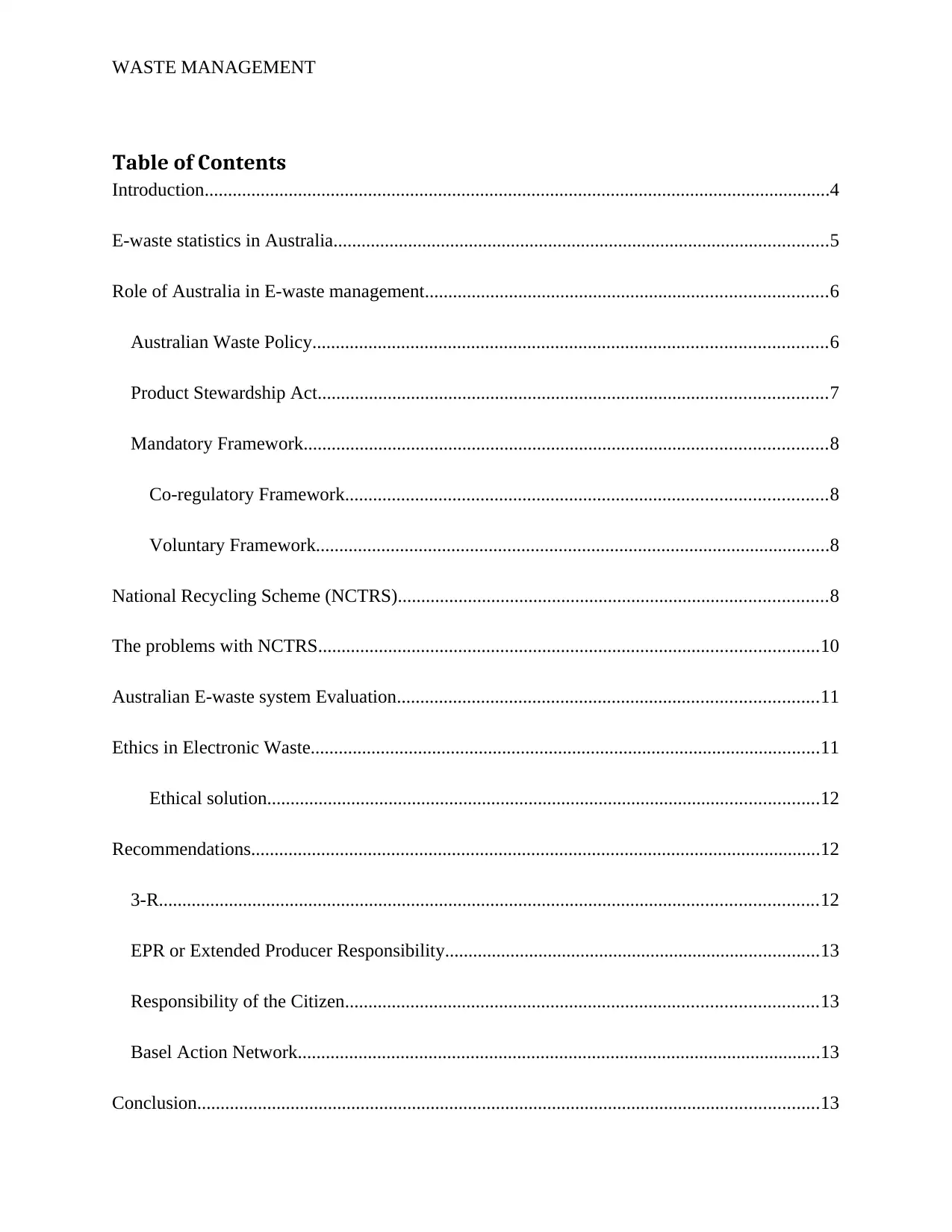
WASTE MANAGEMENT
Table of Contents
Introduction......................................................................................................................................4
E-waste statistics in Australia..........................................................................................................5
Role of Australia in E-waste management......................................................................................6
Australian Waste Policy..............................................................................................................6
Product Stewardship Act.............................................................................................................7
Mandatory Framework................................................................................................................8
Co-regulatory Framework.......................................................................................................8
Voluntary Framework..............................................................................................................8
National Recycling Scheme (NCTRS)............................................................................................8
The problems with NCTRS...........................................................................................................10
Australian E-waste system Evaluation..........................................................................................11
Ethics in Electronic Waste.............................................................................................................11
Ethical solution......................................................................................................................12
Recommendations..........................................................................................................................12
3-R.............................................................................................................................................12
EPR or Extended Producer Responsibility................................................................................13
Responsibility of the Citizen.....................................................................................................13
Basel Action Network................................................................................................................13
Conclusion.....................................................................................................................................13
Table of Contents
Introduction......................................................................................................................................4
E-waste statistics in Australia..........................................................................................................5
Role of Australia in E-waste management......................................................................................6
Australian Waste Policy..............................................................................................................6
Product Stewardship Act.............................................................................................................7
Mandatory Framework................................................................................................................8
Co-regulatory Framework.......................................................................................................8
Voluntary Framework..............................................................................................................8
National Recycling Scheme (NCTRS)............................................................................................8
The problems with NCTRS...........................................................................................................10
Australian E-waste system Evaluation..........................................................................................11
Ethics in Electronic Waste.............................................................................................................11
Ethical solution......................................................................................................................12
Recommendations..........................................................................................................................12
3-R.............................................................................................................................................12
EPR or Extended Producer Responsibility................................................................................13
Responsibility of the Citizen.....................................................................................................13
Basel Action Network................................................................................................................13
Conclusion.....................................................................................................................................13
⊘ This is a preview!⊘
Do you want full access?
Subscribe today to unlock all pages.

Trusted by 1+ million students worldwide

WASTE MANAGEMENT
Reference.......................................................................................................................................14
Reference.......................................................................................................................................14
Paraphrase This Document
Need a fresh take? Get an instant paraphrase of this document with our AI Paraphraser
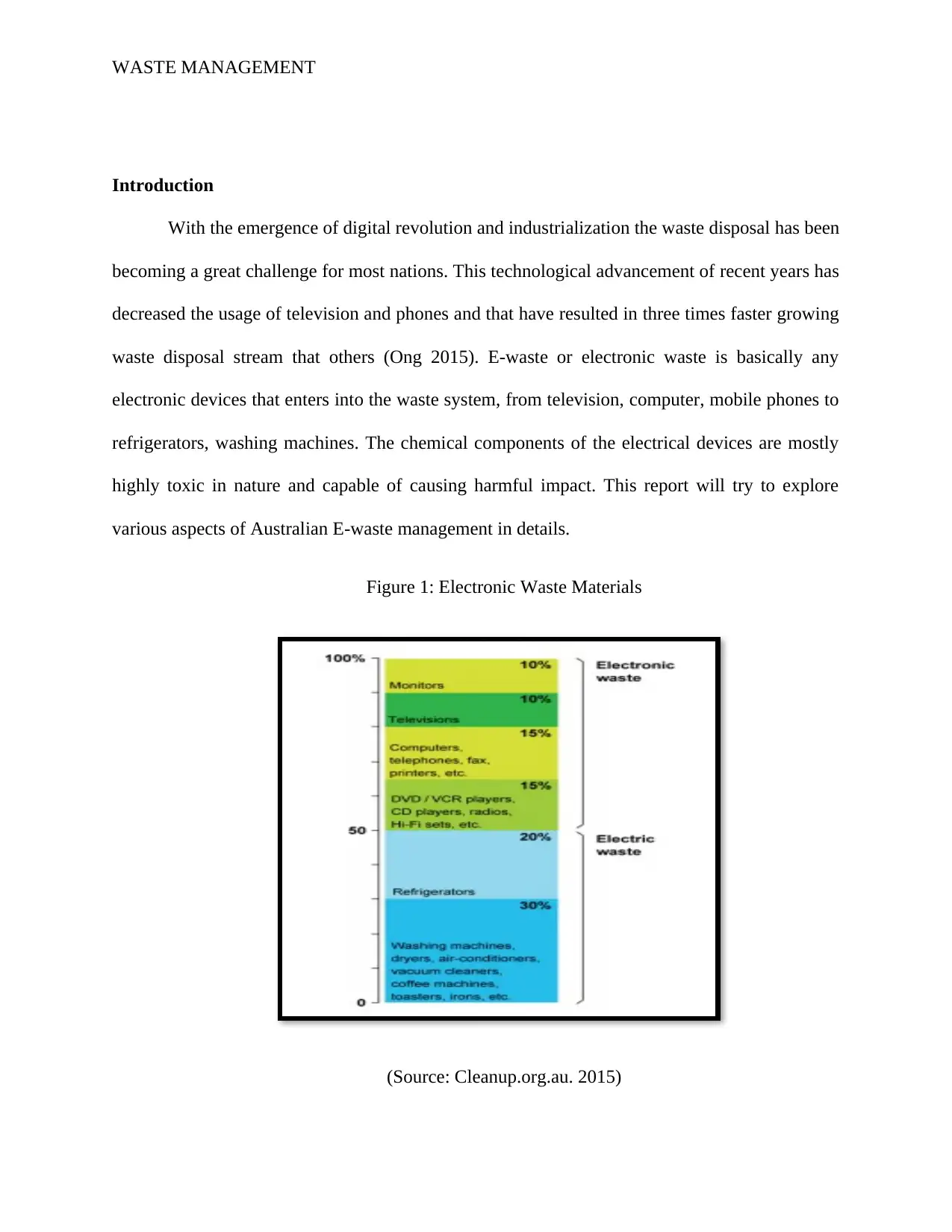
WASTE MANAGEMENT
Introduction
With the emergence of digital revolution and industrialization the waste disposal has been
becoming a great challenge for most nations. This technological advancement of recent years has
decreased the usage of television and phones and that have resulted in three times faster growing
waste disposal stream that others (Ong 2015). E-waste or electronic waste is basically any
electronic devices that enters into the waste system, from television, computer, mobile phones to
refrigerators, washing machines. The chemical components of the electrical devices are mostly
highly toxic in nature and capable of causing harmful impact. This report will try to explore
various aspects of Australian E-waste management in details.
Figure 1: Electronic Waste Materials
(Source: Cleanup.org.au. 2015)
Introduction
With the emergence of digital revolution and industrialization the waste disposal has been
becoming a great challenge for most nations. This technological advancement of recent years has
decreased the usage of television and phones and that have resulted in three times faster growing
waste disposal stream that others (Ong 2015). E-waste or electronic waste is basically any
electronic devices that enters into the waste system, from television, computer, mobile phones to
refrigerators, washing machines. The chemical components of the electrical devices are mostly
highly toxic in nature and capable of causing harmful impact. This report will try to explore
various aspects of Australian E-waste management in details.
Figure 1: Electronic Waste Materials
(Source: Cleanup.org.au. 2015)
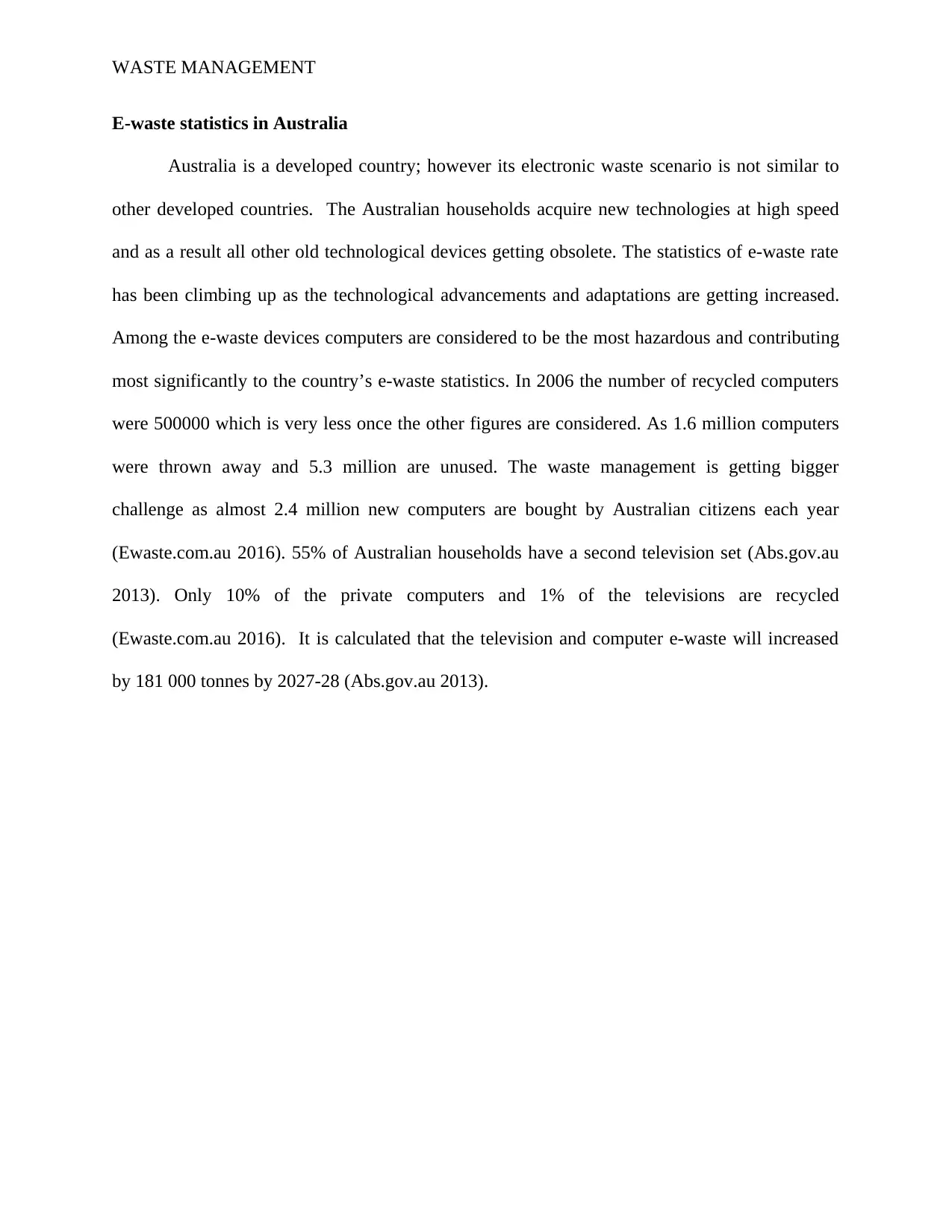
WASTE MANAGEMENT
E-waste statistics in Australia
Australia is a developed country; however its electronic waste scenario is not similar to
other developed countries. The Australian households acquire new technologies at high speed
and as a result all other old technological devices getting obsolete. The statistics of e-waste rate
has been climbing up as the technological advancements and adaptations are getting increased.
Among the e-waste devices computers are considered to be the most hazardous and contributing
most significantly to the country’s e-waste statistics. In 2006 the number of recycled computers
were 500000 which is very less once the other figures are considered. As 1.6 million computers
were thrown away and 5.3 million are unused. The waste management is getting bigger
challenge as almost 2.4 million new computers are bought by Australian citizens each year
(Ewaste.com.au 2016). 55% of Australian households have a second television set (Abs.gov.au
2013). Only 10% of the private computers and 1% of the televisions are recycled
(Ewaste.com.au 2016). It is calculated that the television and computer e-waste will increased
by 181 000 tonnes by 2027-28 (Abs.gov.au 2013).
E-waste statistics in Australia
Australia is a developed country; however its electronic waste scenario is not similar to
other developed countries. The Australian households acquire new technologies at high speed
and as a result all other old technological devices getting obsolete. The statistics of e-waste rate
has been climbing up as the technological advancements and adaptations are getting increased.
Among the e-waste devices computers are considered to be the most hazardous and contributing
most significantly to the country’s e-waste statistics. In 2006 the number of recycled computers
were 500000 which is very less once the other figures are considered. As 1.6 million computers
were thrown away and 5.3 million are unused. The waste management is getting bigger
challenge as almost 2.4 million new computers are bought by Australian citizens each year
(Ewaste.com.au 2016). 55% of Australian households have a second television set (Abs.gov.au
2013). Only 10% of the private computers and 1% of the televisions are recycled
(Ewaste.com.au 2016). It is calculated that the television and computer e-waste will increased
by 181 000 tonnes by 2027-28 (Abs.gov.au 2013).
⊘ This is a preview!⊘
Do you want full access?
Subscribe today to unlock all pages.

Trusted by 1+ million students worldwide
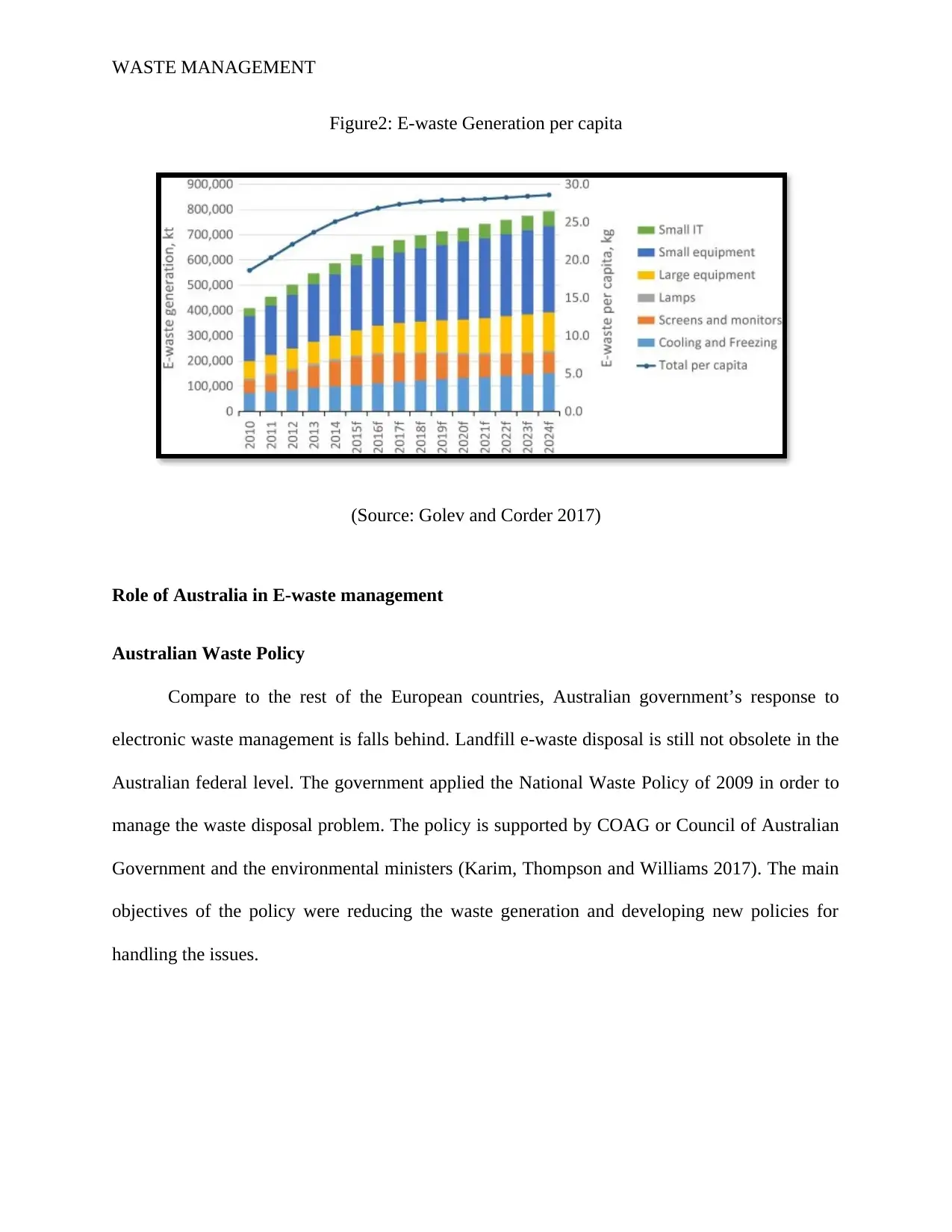
WASTE MANAGEMENT
Figure2: E-waste Generation per capita
(Source: Golev and Corder 2017)
Role of Australia in E-waste management
Australian Waste Policy
Compare to the rest of the European countries, Australian government’s response to
electronic waste management is falls behind. Landfill e-waste disposal is still not obsolete in the
Australian federal level. The government applied the National Waste Policy of 2009 in order to
manage the waste disposal problem. The policy is supported by COAG or Council of Australian
Government and the environmental ministers (Karim, Thompson and Williams 2017). The main
objectives of the policy were reducing the waste generation and developing new policies for
handling the issues.
Figure2: E-waste Generation per capita
(Source: Golev and Corder 2017)
Role of Australia in E-waste management
Australian Waste Policy
Compare to the rest of the European countries, Australian government’s response to
electronic waste management is falls behind. Landfill e-waste disposal is still not obsolete in the
Australian federal level. The government applied the National Waste Policy of 2009 in order to
manage the waste disposal problem. The policy is supported by COAG or Council of Australian
Government and the environmental ministers (Karim, Thompson and Williams 2017). The main
objectives of the policy were reducing the waste generation and developing new policies for
handling the issues.
Paraphrase This Document
Need a fresh take? Get an instant paraphrase of this document with our AI Paraphraser
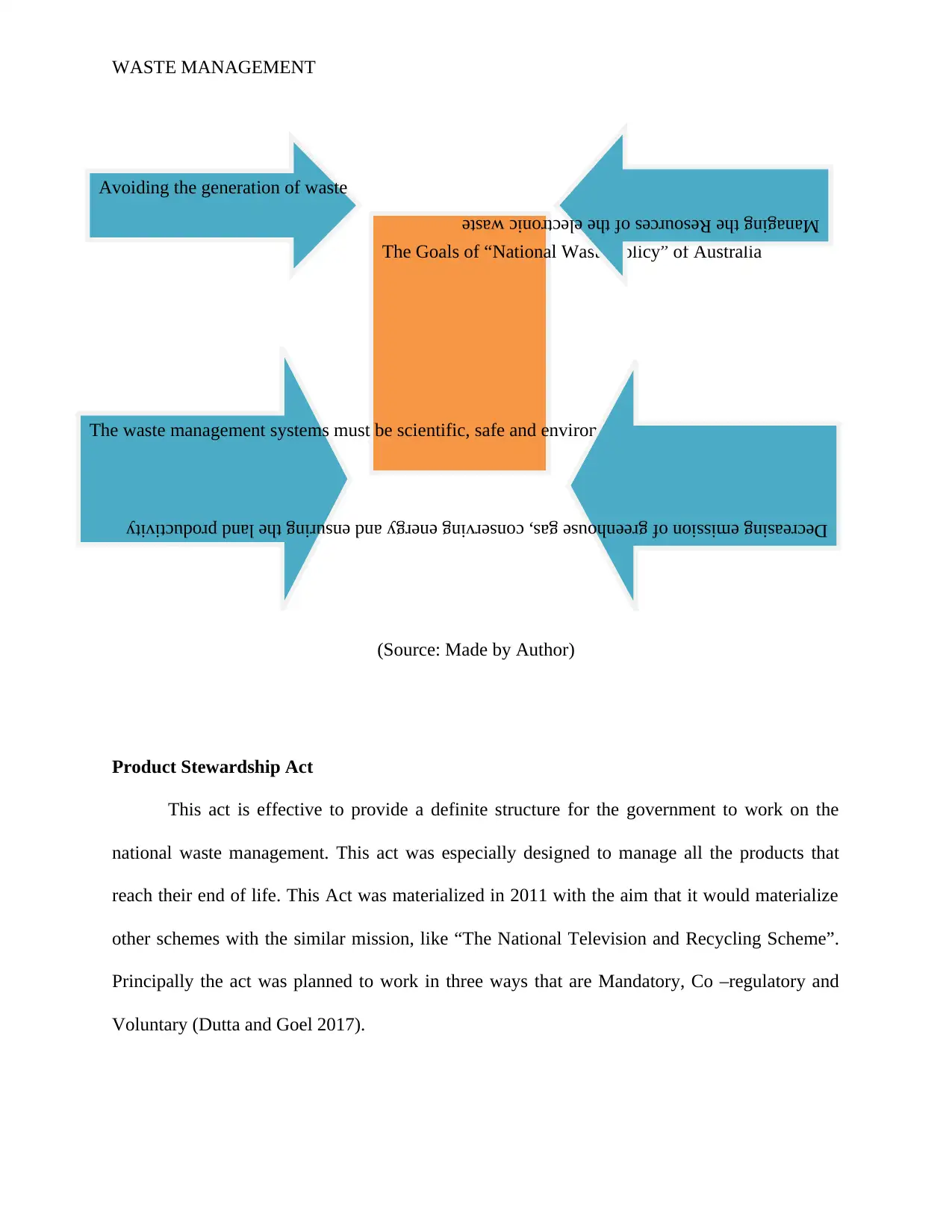
The Goals of “National Waste Policy” of Australia
Avoiding the generation of waste
The waste management systems must be scientific, safe and environment friendly
Managing the Resources of the electronic waste
Decreasing emission of greenhouse gas, conserving energy and ensuring the land productivity
WASTE MANAGEMENT
(Source: Made by Author)
Product Stewardship Act
This act is effective to provide a definite structure for the government to work on the
national waste management. This act was especially designed to manage all the products that
reach their end of life. This Act was materialized in 2011 with the aim that it would materialize
other schemes with the similar mission, like “The National Television and Recycling Scheme”.
Principally the act was planned to work in three ways that are Mandatory, Co –regulatory and
Voluntary (Dutta and Goel 2017).
Avoiding the generation of waste
The waste management systems must be scientific, safe and environment friendly
Managing the Resources of the electronic waste
Decreasing emission of greenhouse gas, conserving energy and ensuring the land productivity
WASTE MANAGEMENT
(Source: Made by Author)
Product Stewardship Act
This act is effective to provide a definite structure for the government to work on the
national waste management. This act was especially designed to manage all the products that
reach their end of life. This Act was materialized in 2011 with the aim that it would materialize
other schemes with the similar mission, like “The National Television and Recycling Scheme”.
Principally the act was planned to work in three ways that are Mandatory, Co –regulatory and
Voluntary (Dutta and Goel 2017).
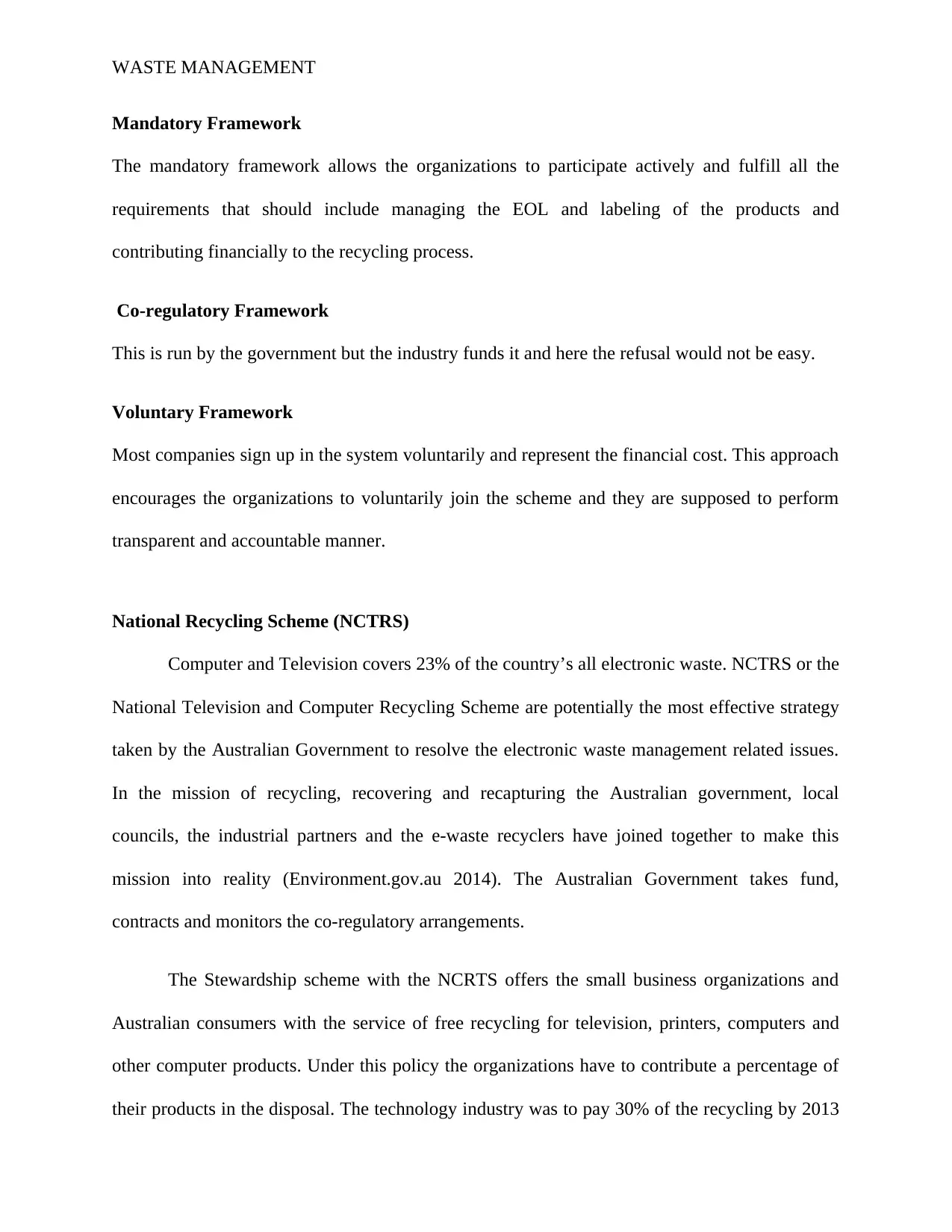
WASTE MANAGEMENT
Mandatory Framework
The mandatory framework allows the organizations to participate actively and fulfill all the
requirements that should include managing the EOL and labeling of the products and
contributing financially to the recycling process.
Co-regulatory Framework
This is run by the government but the industry funds it and here the refusal would not be easy.
Voluntary Framework
Most companies sign up in the system voluntarily and represent the financial cost. This approach
encourages the organizations to voluntarily join the scheme and they are supposed to perform
transparent and accountable manner.
National Recycling Scheme (NCTRS)
Computer and Television covers 23% of the country’s all electronic waste. NCTRS or the
National Television and Computer Recycling Scheme are potentially the most effective strategy
taken by the Australian Government to resolve the electronic waste management related issues.
In the mission of recycling, recovering and recapturing the Australian government, local
councils, the industrial partners and the e-waste recyclers have joined together to make this
mission into reality (Environment.gov.au 2014). The Australian Government takes fund,
contracts and monitors the co-regulatory arrangements.
The Stewardship scheme with the NCRTS offers the small business organizations and
Australian consumers with the service of free recycling for television, printers, computers and
other computer products. Under this policy the organizations have to contribute a percentage of
their products in the disposal. The technology industry was to pay 30% of the recycling by 2013
Mandatory Framework
The mandatory framework allows the organizations to participate actively and fulfill all the
requirements that should include managing the EOL and labeling of the products and
contributing financially to the recycling process.
Co-regulatory Framework
This is run by the government but the industry funds it and here the refusal would not be easy.
Voluntary Framework
Most companies sign up in the system voluntarily and represent the financial cost. This approach
encourages the organizations to voluntarily join the scheme and they are supposed to perform
transparent and accountable manner.
National Recycling Scheme (NCTRS)
Computer and Television covers 23% of the country’s all electronic waste. NCTRS or the
National Television and Computer Recycling Scheme are potentially the most effective strategy
taken by the Australian Government to resolve the electronic waste management related issues.
In the mission of recycling, recovering and recapturing the Australian government, local
councils, the industrial partners and the e-waste recyclers have joined together to make this
mission into reality (Environment.gov.au 2014). The Australian Government takes fund,
contracts and monitors the co-regulatory arrangements.
The Stewardship scheme with the NCRTS offers the small business organizations and
Australian consumers with the service of free recycling for television, printers, computers and
other computer products. Under this policy the organizations have to contribute a percentage of
their products in the disposal. The technology industry was to pay 30% of the recycling by 2013
⊘ This is a preview!⊘
Do you want full access?
Subscribe today to unlock all pages.

Trusted by 1+ million students worldwide
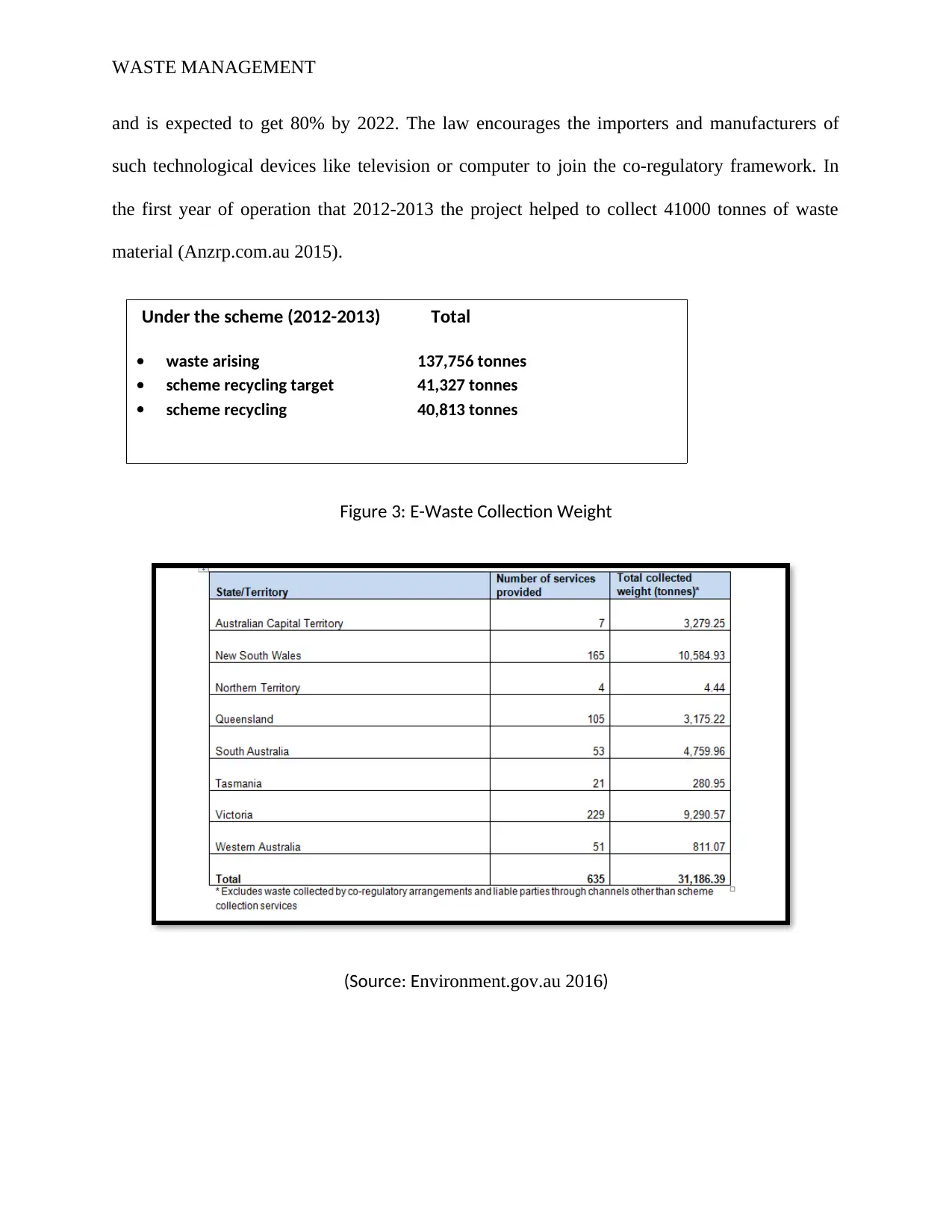
WASTE MANAGEMENT
and is expected to get 80% by 2022. The law encourages the importers and manufacturers of
such technological devices like television or computer to join the co-regulatory framework. In
the first year of operation that 2012-2013 the project helped to collect 41000 tonnes of waste
material (Anzrp.com.au 2015).
Under the scheme (2012-2013) Total
waste arising 137,756 tonnes
scheme recycling target 41,327 tonnes
scheme recycling 40,813 tonnes
Figure 3: E-Waste Collection Weight
(Source: Environment.gov.au 2016)
and is expected to get 80% by 2022. The law encourages the importers and manufacturers of
such technological devices like television or computer to join the co-regulatory framework. In
the first year of operation that 2012-2013 the project helped to collect 41000 tonnes of waste
material (Anzrp.com.au 2015).
Under the scheme (2012-2013) Total
waste arising 137,756 tonnes
scheme recycling target 41,327 tonnes
scheme recycling 40,813 tonnes
Figure 3: E-Waste Collection Weight
(Source: Environment.gov.au 2016)
Paraphrase This Document
Need a fresh take? Get an instant paraphrase of this document with our AI Paraphraser
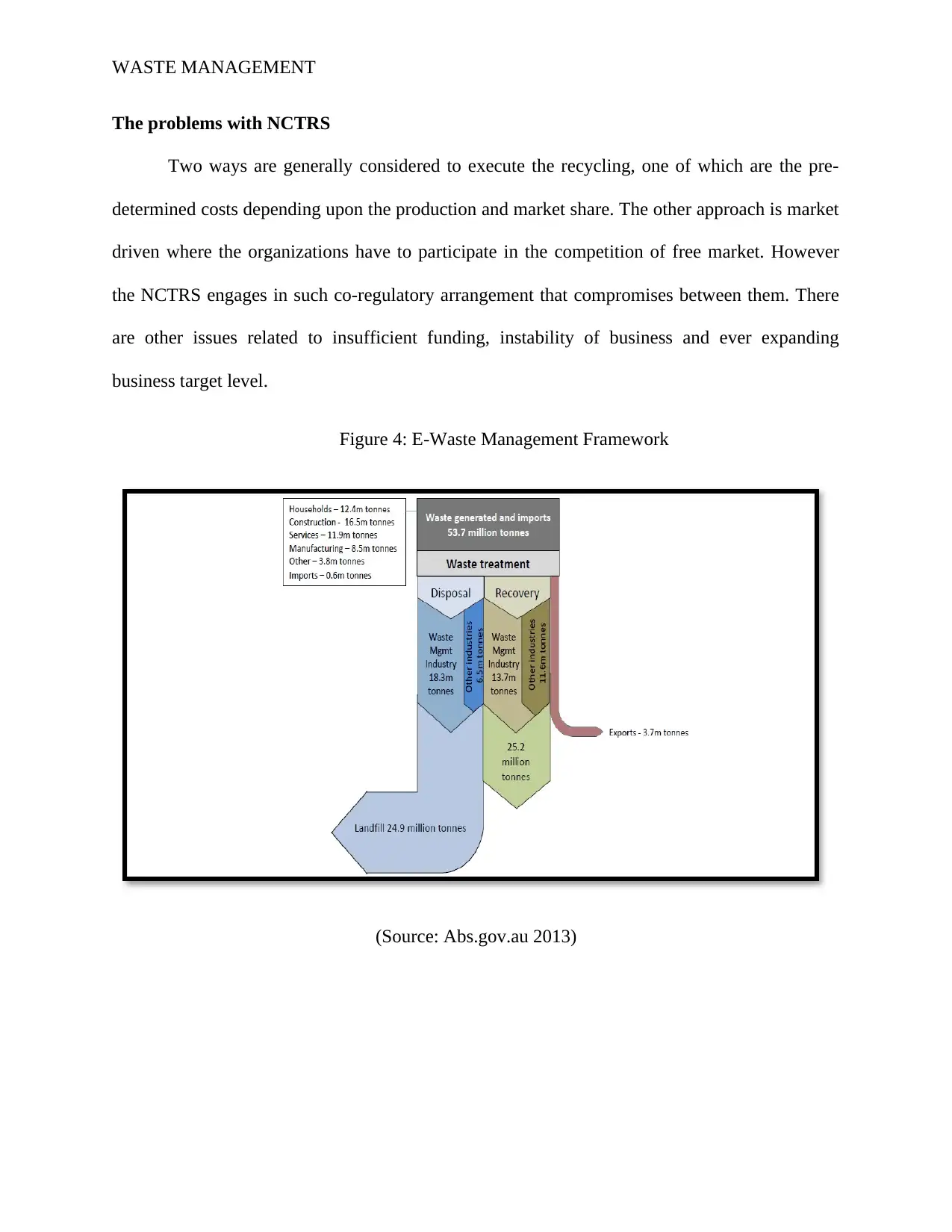
WASTE MANAGEMENT
The problems with NCTRS
Two ways are generally considered to execute the recycling, one of which are the pre-
determined costs depending upon the production and market share. The other approach is market
driven where the organizations have to participate in the competition of free market. However
the NCTRS engages in such co-regulatory arrangement that compromises between them. There
are other issues related to insufficient funding, instability of business and ever expanding
business target level.
Figure 4: E-Waste Management Framework
(Source: Abs.gov.au 2013)
The problems with NCTRS
Two ways are generally considered to execute the recycling, one of which are the pre-
determined costs depending upon the production and market share. The other approach is market
driven where the organizations have to participate in the competition of free market. However
the NCTRS engages in such co-regulatory arrangement that compromises between them. There
are other issues related to insufficient funding, instability of business and ever expanding
business target level.
Figure 4: E-Waste Management Framework
(Source: Abs.gov.au 2013)
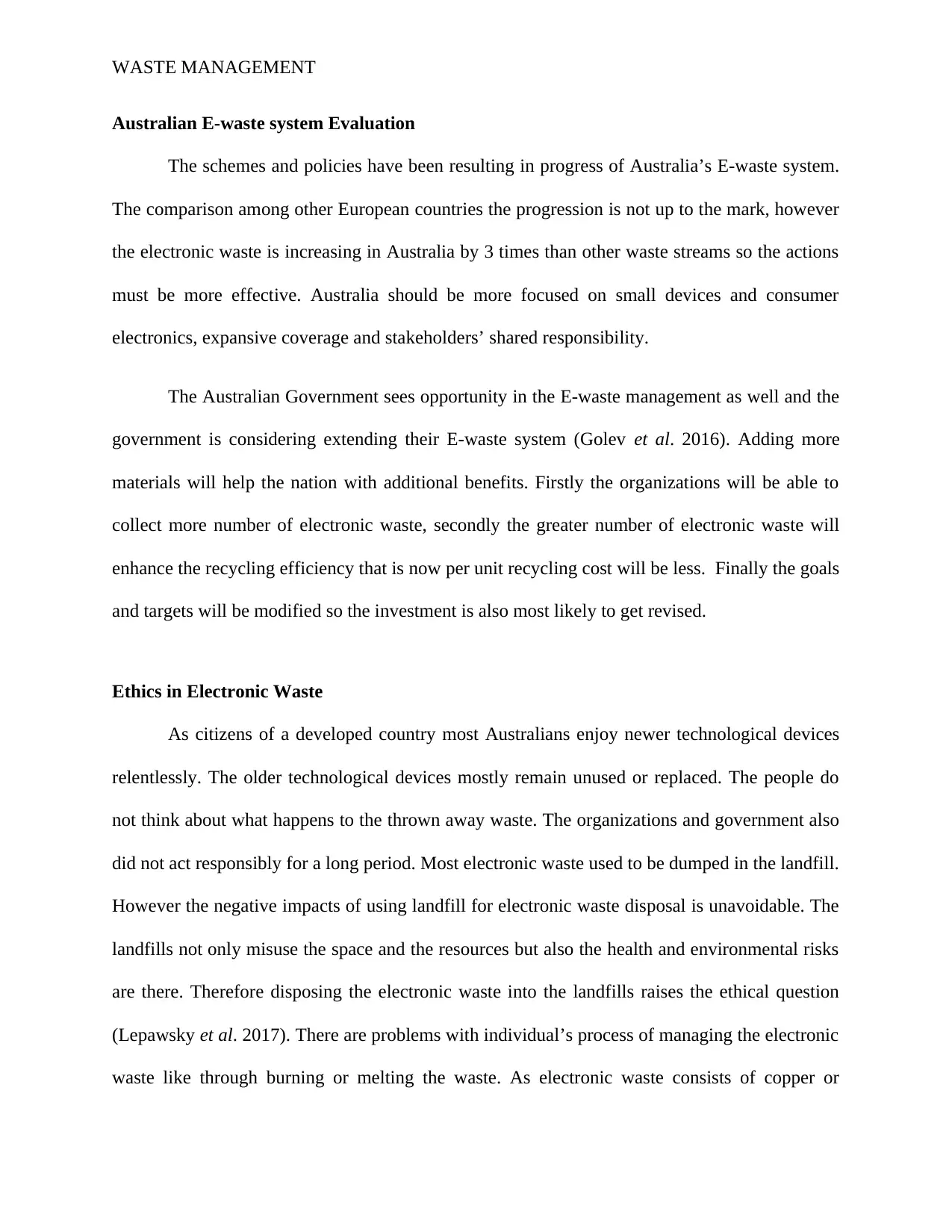
WASTE MANAGEMENT
Australian E-waste system Evaluation
The schemes and policies have been resulting in progress of Australia’s E-waste system.
The comparison among other European countries the progression is not up to the mark, however
the electronic waste is increasing in Australia by 3 times than other waste streams so the actions
must be more effective. Australia should be more focused on small devices and consumer
electronics, expansive coverage and stakeholders’ shared responsibility.
The Australian Government sees opportunity in the E-waste management as well and the
government is considering extending their E-waste system (Golev et al. 2016). Adding more
materials will help the nation with additional benefits. Firstly the organizations will be able to
collect more number of electronic waste, secondly the greater number of electronic waste will
enhance the recycling efficiency that is now per unit recycling cost will be less. Finally the goals
and targets will be modified so the investment is also most likely to get revised.
Ethics in Electronic Waste
As citizens of a developed country most Australians enjoy newer technological devices
relentlessly. The older technological devices mostly remain unused or replaced. The people do
not think about what happens to the thrown away waste. The organizations and government also
did not act responsibly for a long period. Most electronic waste used to be dumped in the landfill.
However the negative impacts of using landfill for electronic waste disposal is unavoidable. The
landfills not only misuse the space and the resources but also the health and environmental risks
are there. Therefore disposing the electronic waste into the landfills raises the ethical question
(Lepawsky et al. 2017). There are problems with individual’s process of managing the electronic
waste like through burning or melting the waste. As electronic waste consists of copper or
Australian E-waste system Evaluation
The schemes and policies have been resulting in progress of Australia’s E-waste system.
The comparison among other European countries the progression is not up to the mark, however
the electronic waste is increasing in Australia by 3 times than other waste streams so the actions
must be more effective. Australia should be more focused on small devices and consumer
electronics, expansive coverage and stakeholders’ shared responsibility.
The Australian Government sees opportunity in the E-waste management as well and the
government is considering extending their E-waste system (Golev et al. 2016). Adding more
materials will help the nation with additional benefits. Firstly the organizations will be able to
collect more number of electronic waste, secondly the greater number of electronic waste will
enhance the recycling efficiency that is now per unit recycling cost will be less. Finally the goals
and targets will be modified so the investment is also most likely to get revised.
Ethics in Electronic Waste
As citizens of a developed country most Australians enjoy newer technological devices
relentlessly. The older technological devices mostly remain unused or replaced. The people do
not think about what happens to the thrown away waste. The organizations and government also
did not act responsibly for a long period. Most electronic waste used to be dumped in the landfill.
However the negative impacts of using landfill for electronic waste disposal is unavoidable. The
landfills not only misuse the space and the resources but also the health and environmental risks
are there. Therefore disposing the electronic waste into the landfills raises the ethical question
(Lepawsky et al. 2017). There are problems with individual’s process of managing the electronic
waste like through burning or melting the waste. As electronic waste consists of copper or
⊘ This is a preview!⊘
Do you want full access?
Subscribe today to unlock all pages.

Trusted by 1+ million students worldwide
1 out of 16
Related Documents
Your All-in-One AI-Powered Toolkit for Academic Success.
+13062052269
info@desklib.com
Available 24*7 on WhatsApp / Email
![[object Object]](/_next/static/media/star-bottom.7253800d.svg)
Unlock your academic potential
Copyright © 2020–2025 A2Z Services. All Rights Reserved. Developed and managed by ZUCOL.





